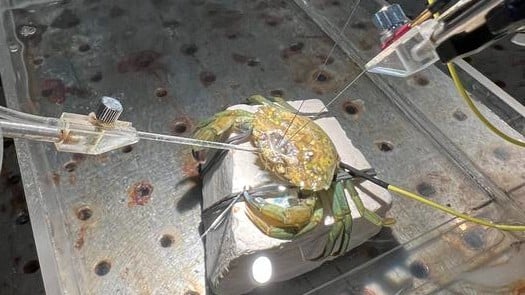Published in Biology | Estimated reading time: 4 minutes
The research team, led by PhD student Eleftherios Kasiouras and zoophysiologist Dr. Lynne Sneddon, conducted unprecedented in vivo recordings of crab brain activity during exposure to potentially harmful stimuli. Their findings reveal that shore crabs (Carcinus maenas) possess remarkably sensitive neural mechanisms for detecting tissue damage.
“We need to find less painful ways to kill shellfish if we are to continue eating them. Because now we have scientific evidence that they both experience and react to pain,” says Lynne Sneddon, zoophysiologist at the University of Gothenburg.
The study examined how crabs’ central nervous systems responded when researchers applied either mechanical pressure or acetic acid to soft tissues throughout their bodies. “We could see that the crab has some kind of pain receptors in its soft tissues, because we recorded an increase in brain activity when we applied a potentially painful chemical, a form of vinegar, to the crab’s soft tissues,” explains Kasiouras.
The research revealed several key findings about crabs’ sensitivity to potential tissue damage:
- Their eyes and leg joints showed remarkable sensitivity, responding to pressures as low as 0.008 grams – far more sensitive than both fish (0.1g) and humans (0.6g)
- Different body parts displayed varying sensitivity levels, with eyes and antennules responding to chemical concentrations as low as 0.1% acetic acid
- Mechanical stimuli produced brief, intense neural responses, while chemical irritants triggered longer-lasting activity
- The antennae showed specialized responses, reacting only to chemical stimuli and not to mechanical pressure
The implications extend beyond shore crabs to other crustaceans. As Kasiouras notes, “It is a given that all animals need some kind of pain system to cope by avoiding danger. I don’t think we need to test all species of crustaceans, as they have a similar structure and therefore similar nervous systems.”
Glossary
- Nociceptors
- Sensory receptors that detect potentially harmful stimuli and transmit signals to the central nervous system
- Electrophysiology
- The study of electrical activity in biological systems, including neural signals
- Central Nervous System (CNS)
- The brain and main nerve centers that process sensory information
Test Your Knowledge
What methods did researchers use to test the crabs’ responses to potential tissue damage?
Researchers used mechanical pressure (von Frey hairs) and chemical stimuli (acetic acid) while recording brain activity through electrophysiological measurements.
How sensitive were the crabs’ eyes and leg joints to mechanical pressure?
They responded to pressures as low as 0.008 grams, which is more sensitive than both fish (0.1g) and humans (0.6g).
How did the neural responses differ between mechanical and chemical stimuli?
Mechanical stimuli produced shorter, more intense neural responses, while chemical stimuli triggered longer-lasting activity in the central nervous system.
What was discovered about the relationship between acid concentration and tissue damage?
Higher concentrations (5%) of acetic acid appeared to damage receptors, rendering them unresponsive to subsequent stimuli, while moderate concentrations (1%) produced optimal responses for measurement.
Enjoy this story? Subscribe to our newsletter at scienceblog.substack.com.
If our reporting has informed or inspired you, please consider making a donation. Every contribution, no matter the size, empowers us to continue delivering accurate, engaging, and trustworthy science and medical news. Independent journalism requires time, effort, and resources—your support ensures we can keep uncovering the stories that matter most to you.
Join us in making knowledge accessible and impactful. Thank you for standing with us!

